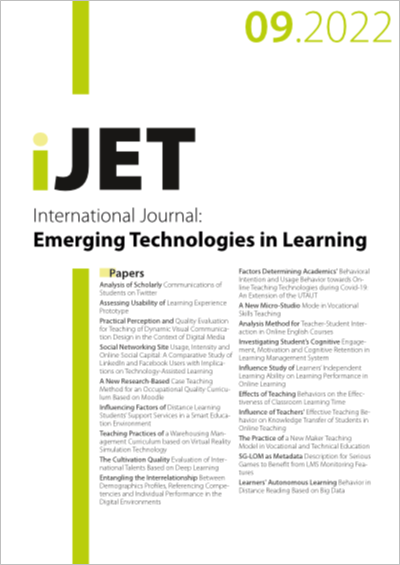Analysis of Scholarly Communications of Students on Twitter
DOI:
https://doi.org/10.3991/ijet.v17i09.27197Keywords:
ARCS, ERGM, online connections, Twitter, university studentsAbstract
As part of an applied activity of a university course in Japan, a total of 65 students posted messages on Twitter regarding global issues to expand the scope of scholarly communication with social users on Twitter. The students’ motivations to learn about world issues were evaluated using a standard questionnaire developed under the attention, relevance, confidence, and satisfaction (ARCS) model. Thereafter, students’ connections were categorized into three types: crossing, private, and isolation. A one-way analysis of variance test and multiple comparison test showed a significant result—students with higher levels of motivation could communicate with users in other communities of the crossing type. In this study, we tried for the first time to utilize social network analysis and exponential random graph models to investigate the motivation and structures of scholarly connections on Twitter. Although students selected social users as targets for tweeting, most students who had reciprocal ties with these users did not contribute to the expansion of the community. Since the requirement to be a popular user was explicated by focusing on a remarkable student in the community, the inner-community enhancement of increasing ties among students was concluded for developing social capital in the community.
Downloads
Published
2022-05-10
How to Cite
Yoshida, M., & Petsangsri, S. (2022). Analysis of Scholarly Communications of Students on Twitter. International Journal of Emerging Technologies in Learning (iJET), 17(09), pp. 4–19. https://doi.org/10.3991/ijet.v17i09.27197
Issue
Section
Papers
License
Copyright (c) 2022 Masami YOSHIDA, Sirirat Petsangsri

This work is licensed under a Creative Commons Attribution 4.0 International License.


